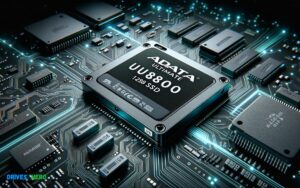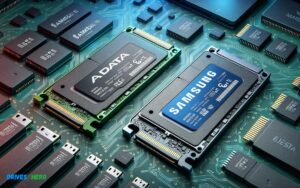How to Install Adata Ssd? 10 Steps!
Installing an ADATA SSD is a straightforward process that can make a significant difference in performance. Follow these simple steps to upgrade your system and enjoy faster load times and smoother operation.

Key Takeaway
Step-by-Step Guide to Installing an ADATA SSD
Step 1: Gather Your Tools and Materials
Ensure you have the necessary tools: a screwdriver, your ADATA SSD, and any adapters if needed.
Step 2: Shut Down Your Computer
Power off your computer completely and disconnect all cables.
Step 3: Open Your Computer Case
Remove the screws securing your computer case and carefully slide off the side panel.
Step 4: Locate the Drive Bay
Identify an empty drive bay where you’ll install the ADATA SSD. It’s usually near the existing hard drive or other SSD.
Step 5: Mount the SSD
If your SSD doesn’t have a bracket, use screws to secure it into the drive bay. Align the screw holes on the SSD with those on the bay and tighten the screws.
Step 6: Connect the SATA Cable
Locate an available SATA port on your motherboard. Connect one end of the SATA cable to the SSD and the other end to the motherboard’s SATA port.
Step 7: Connect the Power Cable
Connect the power cable from your power supply unit (PSU) to the SSD. This usually involves a SATA power connector.
Step 8: Close Your Computer Case
Carefully slide the side panel back onto your computer case and secure it with the screws you removed earlier.
Step 9: Power On Your Computer
Reconnect all cables to your computer and power it on.
Step 10: Check for Recognition
Once your computer boots up, go to your operating system and check if the ADATA SSD is recognized. You may need to format it before use.
You’ve successfully installed your ADATA SSD. Enjoy the improved speed and performance it brings to your system.
Opening The Device
Before installing your Adata SSD, ensure the device is powered off to prevent any electrical damage. Gently open the computer case or laptop access panel to reveal the internal components for the SSD installation.
Laptop Opening
Laptops come with their own set of intricacies when it comes to installation upgrades. With compact design and often unique screw placements, it’s essential to proceed with care.
Required Steps For Laptops
- Power Down – Ensure the laptop is turned off and unplugged from any power sources.
- Safe Workspace – Set up a clean, static-free work environment to perform the installation.
- Disassembly Precautions – Remove any external devices and unscrew the back panel carefully, keeping track of the screws and their corresponding slots.
Desktop Opening
Desktops typically offer a more straightforward approach to upgrades, yet precision and caution are equally important.
Required Steps For Desktops
- Shut Down – Completely power off the desktop and disconnect all cables.
- Prep the Area – Ensure your workspace is organized and ready for the task at hand.
- Access the Interior – Remove the side panel by unscrewing or sliding it off, depending on the case design.
Troubleshooting And Optimizing
Discover the essential steps for installing an Adata SSD on your machine, ensuring a significant performance upgrade.
Navigate potential hiccups with ease, and fine-tune your system for optimal results, unlocking faster boot times and improved data transfer speeds.
Troubleshooting
Begin your troubleshooting process by ensuring all connections are secure. An improperly connected SSD can cause myriad issues which are often mistaken for hardware defects. Verify that both the power and data cables are firmly connected between your SSD and the motherboard.
If issues persist, consider the following steps:
- Check the SATA port on the motherboard for damage.
- Try using a different SATA data cable.
- Consult your motherboard manual to confirm compatibility and the correct BIOS settings.
- Perform a BIOS update if your current version does not support the SSD.
Addressing Common Installation Issues
- Double-check the boot order in the BIOS.
- Use disk management tools to ensure the SSD is properly initialized.
- If the drive shows up but won’t hold a partition, consider a secure erase and format.
Optimizing
Once the SSD is successfully installed and recognized by your system, it’s time to focus on optimization.
Optimize the SSD’s performance by:
- Updating the SSD firmware to the latest version available from Adata.
- Enabling TRIM support in your operating system to maintain the highest levels of performance over time.
- Adjusting system settings, such as disabling defragmentation schedules as they are unnecessary and potentially harmful to SSDs.
Tips For Maximizing Adata Ssd Performance
To ensure you are making the most out of your Adata SSD, follow these tips:
| Tip | Action |
|---|---|
| Boot Efficiency | Enable AHCI mode in your BIOS settings for better performance and improved boot times. |
| System Tweak | Customize your power settings in the OS for maximum performance, especially if you’re using a desktop. |
| Software Update | Install the Adata SSD Toolbox to monitor SSD health, update firmware, and optimize system settings. |
By carefully following these troubleshooting and optimization steps, your Adata SSD will be running at peak performance, providing you with a fast and reliable storage solution.
Is Adata a good brand SSD?
Yes, generally speaking, Adata is considered a good brand for SSDs.
Here’s a quick rundown of some of the key strengths of Adata SSDs:
- Performance: Adata SSDs perform very well, especially their higher-end NVMe models. Sequential read/write speeds are competitive with leading brands. Everyday responsiveness and boot times are fast.
- Value: Adata drives tend to be priced lower than comparable models from top-tier brands like Samsung and WD. You can often get better specs and capacity for the money.
- Quality & Reliability: Reviews show Adata SSDs meeting their advertised specs and benchmarks. Their NAND flash and controllers may not be cutting edge but are reliable. Most drives come with a 3 to 5 years warranty providing some confidence.
- Range of Options: Adata offers a wide range from SATA drives to high speed PCIe Gen3 and Gen4 NVMe SSDs. This caters to budget builds as well as high-end gaming rigs.
- Constant Firmware Updates: Adata has improved compatibility and fixed bugs through rapid firmware updates when any issues are found.
While not considered a top-tier brand, Adata SSDs offer great performance for the money. For system builders on a budget, they deliver excellent value. I would recommend them as a good, affordable SSD choice.
Is Adata SSD any good?
Adata makes a wide range of SSDs (solid state drives) that span different performance and price points.
Here’s a quick overview:
- Adata SSDs are generally considered reliable and offer good performance for the price. They are not typically the fastest SSDs on the market but provide good value overall.
- Their mainstream consumer SATA SSDs like the SU650 and SU800 offer similar real-world speeds to competitors in their price range. They don’t lead benchmarks but deliver solid everyday performance.
- Adata also makes faster NVMe SSDs like their XPG SX8200 Pro which competes well with drives like the Samsung 970 EVO. These are geared more for gaming, content creation, and performance PCs.
- Build quality on Adata SSDs may not be as premium feeling as some pricier brands but they should last well with typical usage. Their 3-5 year warranties provide decent coverage too.
- One advantage of Adata is they frequently have sales and deals that make their drives even more budget-friendly for the performance.
While Adata doesn’t make top-tier cutting-edge SSDs, their drives are very solid in terms of reliability, speed for the cost, and overall value. For system builds focused on price/performance, they are definitely worth considering.
Conclusion
Upgrading your system with an Adata SSD is a smart move for speed and reliability. Keep in mind the simple steps covered, ensuring proper connection and setup.
Should issues arise, consult the manual or reach out to customer support. Embrace the performance boost your device will now enjoy with your new SSD installed.



